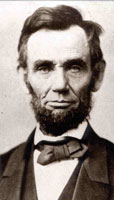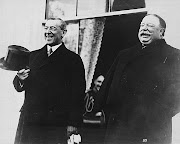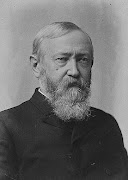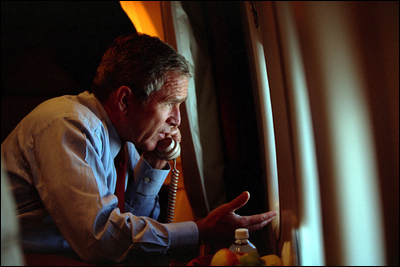 Years in office: 1837-1841
Years in office: 1837-1841Pre-service occupations: governor of New York, U.S. Senator, secretary of state (Jackson), vice president (Jackson)
Key events during his administration: Panic of 1837 (financial depression), Trail of Tears (1838), Aroostook “War” (1837-38), Missouri Mormon War (1838), Amistad Supreme Court Case (1840-41)
Presidential rating: Near failure, and mixed on popularity, but nevertheless a brilliant politician
ESSAY
Martin Van Buren was robbed.
Robbed of his rightful place in American politics. In truth, Democrats should be celebrating Jefferson-Jackson-Van Buren dinners every year. Not because Van Buren was a great president—neither was Jefferson (or more correctly, Jefferson didn’t want his presidency to even be remembered)—but because Van Buren had as much, if not more, to do with the foundation of the Democratic Party as did the scion of Monticello.
In fact, Martin Van Buren was one of the most brilliant politicos this country has ever produced. He just wasn’t a good president—or rather, he was utterly squashed by a massive event mere weeks into his presidency that he never recovered from—and hence, he remains the first of many “forgotten” presidents.
These days, Van Buren turns up as a crank and tool of slave owners in Spielberg’s movie Amistad and as the butt of a joke in a hilarious Sienfeld episode where Kramer joins a gang dedicated to the 8th president’s memory.
But the real man was a lawyer and wily professional politician who rarely lost—until he won the biggest office in the land. Van Buren sought to succeed Jackson in the White House, but when he did, the Little Magician became the first in a long line of one-term presidents (sans Harrison and Taylor) of dubious success between 1837 and 1860, most of whom are equally “forgotten.”
Democratic kingpin
Van Buren, as fluent in Dutch as he was in English, would become the first president not of British stock—and the first one bor
 n in America after she became a country. He called “home” the mid-state New York town of Kinderhook, a closed, private Dutch community that also attracted Washington Irving to its Old World charms.
n in America after she became a country. He called “home” the mid-state New York town of Kinderhook, a closed, private Dutch community that also attracted Washington Irving to its Old World charms.He would fall in love and marry young, but his wife would die of tuberculosis in 1819, and Van Buren remained a widower the rest of his life. It could be said that ever-after, his first love was the political arena: for many a man went into battle against the mild-mannered and squat Van Buren and came away wondering what in the heck happened to him.
As Van Buren made his reputation in the courtroom, he turned toward politics. He found a mentor in the most infamous character from the early republic: fellow New Yorker Aaron Burr. A vicious rumor survived into the 20th century that Burr was Van Buren’s illegitimate father (most recently propagated by Gore Vidal in his novel about Burr) but there never was proof of it. Van Buren started out as an ally of the Clintonians, but soon made an enemy in the powerful DeWitt Clinton, who would be the longtime mayor of New York City and then New York governor.
After he had been in state government service for a decade—and had split with the Clintonians—Van Buren’s brilliance for political organization first emerged. During the teens, the man from Kinderhook created a new type of political creature encompassing the entire state. This machine was built upon respect, discipline, cooperation, and communication and voting. Nothing like it had been seen before in America. He didn’t do it alone, but rather took advantage of existing structures and groups and streamlined them, took them over, guided them or exploited them in order to mold them into a single entity. Van Buren’s overarching group became known as the Albany Regency. For this, he earned the knick name, the Little Magician.
In 1821, Van Buren moved to the national scene, being elected to the U.S. Senate, and set about repeating what he had done in New York. It didn’t happen smoothly, and not all at once. He received a “laying of the hands” by Jefferson himself before the latter died, and vowed to rescue the nation from “misrule.” Eventually, he would throw in with Andrew Jackson’s second attempt at the presidency when it became clear that the unpopular John Quincy Adams would not stand against the Jackson juggernaut.
Van Buren essentially created a grassroots-style of politicking that we’re familiar with: parties, parades, speeches, rallies, and communications. The Jackson press was already fired up in 1828, as were Jackson’s supporters, but Van Buren targeted the people themselves. Without votes, all the newspapers and high-level supporters were worthless. It was an incredible effort, as the “old Democrat” party of Jefferson, organized by Van Buren behind the scenes, literally rallied for Jackson all over the country. Even without the nastiness of the 1828 election, Adams wouldn’t have stood a chance.
In Jackson’s shadow – or casting a shadow?
Meanwhile, Van Buren had been elected to a new position of his own—governor of New York—but the position was short lived, as the new president soon called his benefactor (is there really another word?) to the capitol to be his secretary of state. After the doings of John C. Calhoun (see the entry on President Jackson), Van Buren would four years later become the vice president—a new type of heir-apparent.
 It is interesting to look at Van Buren and Jackson through different eyes. Admirers of Jackson see Van Buren as one of Jackson’s strongest supporters, while admirers of Van Buren—they do exist—view Van Buren as the soothing architect who would mollify the extremes of Jackson’s positions, especially when the president would go on a tear against a chosen target, such as the Second Bank of the United States. Who is right depends on where one’s sympathies rest, it seems.
It is interesting to look at Van Buren and Jackson through different eyes. Admirers of Jackson see Van Buren as one of Jackson’s strongest supporters, while admirers of Van Buren—they do exist—view Van Buren as the soothing architect who would mollify the extremes of Jackson’s positions, especially when the president would go on a tear against a chosen target, such as the Second Bank of the United States. Who is right depends on where one’s sympathies rest, it seems.But there is little doubt that Van Buren was a much cooler head in the Jackson administration that the president himself. And it also became apparent that the then-secretary of state was Jackson’s chosen successor. A second new party, to counter the new “Democracy,” formed against Jackson and Van Buren: the Whigs, which included such political luminaries as Daniel Webster and Henry Clay. Succession became even more certain when Jackson easily crushed Clay in 1832, crushed the Nullifiers in 1833, and the Bank soon after, and appeared to be shepherding the country to good times through the end of his second term.
The Little Magician, with the sainted Jackson’s full blessing, easily defeated three Whig candidates opposing him. The Democratic Party fully came into existence and was here to stay by the 1836 election. Although Van Buren didn’t do it alone, he was the chief architect in the party’s formation and therefore of his own victory. And now he was about to enjoy—so he rightfully believed—the ultimate fruit of a decade and a half’s worth of labor.
But neither he nor anyone else, really, was aware of just how bad life was going to get just a few weeks after the March 1837 inauguration.
Crash
The Panic of 1837 shook America to its core. It was worse than the previous financial crisis, and that’s not just hyperbole.
The limits of Jeffersonian democracy became all-too apparent, because for all Van Buren’s political wizardry in organizing a party, the party’s ideals were centered around a limited government: one not equipped to deal with major financial depression. Biographer Ted Widmer describes the impact on Van Buren and America (with somewhat flowery imagery):
“Only ten years before Van Buren’s election, Thomas Jefferson and John Adams had died on the same day, July 4, 1826, the fiftieth anniversary of the Declaration of Independence. Sermons across the land proclaimed that a special providence was guiding America’s destiny, and it was hard at the time to refute the evidence. But now retribution was at hand. The Panic caused a terrible shock, both financially and psychologically. It drained confidence—that precious resource that Americans seem to drink in like oxygen. And the Panic was really only the surface manifestation of other problems that suddenly were revealed in the harsher light that accompanies hard times. What had felt like effortless progress was badly interrupted in 1837. Everything Van Buren had worked to build—his party, his presidency, his reputation for political sagacity—was imperiled by the tsunami that struck almost the exact moment he took office.” (pp.106-107)The description is mostly accurate, because although America had experienced financial distress before (such as after the War of 1812), the effects were less severe because the country was less connected, and in 1837 there was much more speculation and much more growth affecting far more ordinary and wealthy people. Until 1837, the government had no means to deal with a financial panic, and really wouldn’t for several more decades, though President Van Buren did his best to handle something the federal government was as yet not equipped to handle.
There were things he could do to affect the high unemployment, banks issuing increasingly worthless paper money (as opposed to “hard” currency of gold and silver coins), etc. Some of his best ideas included selling U.S. bonds and lowering the tariff. But Congress failed to act on his best idea, making the U.S. Treasury independent, until 1840. Van Buren’s most interesting idea was to have the Treasury control all federal funds and require all payments be made in legal tender instead of bank notes. The act was repealed in 1841.
Ultimately, the country recovered from the shock and years of the depression without too much in the way of government assistance. Remember, this was an age when state governments had much more impact on life than the federal government—but Van Buren was still blamed mercilessly, and never recovered.
Chains, or Van Buren trapped in his own party
While the country started inching back from the Panic, slavery finally began to take center stage. After a brief moment in the public eye during the tense fight in 1820 that led to the Missouri Compromise, America’s “peculiar institution” and great contradiction retreated behind polite conversation.
But a combination of events forced slavery out into the open in the 1830s, where it remained for the next three decades until the climatic clash of arms. First, there was the Nat Turner rebellion in 1831 in Virginia, where the slave revolt killed 51 whites and freaked out slaveholders for the rest of the decade. Then there was the Transcendental movement, the tail end of the Second Great Awakening, and the growth of the abolitionist movement in the 1830s, which saw the rise of William Lloyd Garrison, authors Ralph Waldo Emerson, Henry David Thoreau, Edgar Allen Poe—and they all made proficient use of the printing press to disseminate their ideas by book and newspaper. One of those newspaper’s editors, Elijah Lovejoy, was murdered in Illinois the same year Van Buren became president. Finally, anti-slavery forces found an unlikely free speech champion in Congress in the form of John Quincy Adams, who railed frequently against the Gag rules preventing slavery from being discussed in Congress (see the Adams entry for more).
It’s difficult to know where President Van Buren stood on slavery because the Little Magician deliberately kept his intentions hidden. After all, he had a national coalition to hold together, which was not easy; Southern Democrats, led by the resurgent Calhoun, were becoming more outspoken in defending slavery while Northern Democrats were becoming wary of it. Consequently, each section thought that Van Buren favored the other!
What did he really think? On the surface,  we get clues that he wanted the abolitionists to shut up so they wouldn’t disrupt his political party, but secretly he did not care for slavery. As president, he pledged to not interfere with it—he became the first president to mention it in his inaugural address. But on a different level, Van Buren was strangely—or refreshingly, to look at it one way—unconcerned about it, at least as far as race was concerned. His vice president was Richard M. Johnson of Kentucky, a slave owner who did the heretical thing of falling in love with one of his slaves, Julia Chinn. They had two daughters. Biographer Widmer points out that it is fascinating to speculate the firestorm that would have erupted had Van Buren died or been removed from office, and Johnson became president—and his ex-slave had been his wife!
we get clues that he wanted the abolitionists to shut up so they wouldn’t disrupt his political party, but secretly he did not care for slavery. As president, he pledged to not interfere with it—he became the first president to mention it in his inaugural address. But on a different level, Van Buren was strangely—or refreshingly, to look at it one way—unconcerned about it, at least as far as race was concerned. His vice president was Richard M. Johnson of Kentucky, a slave owner who did the heretical thing of falling in love with one of his slaves, Julia Chinn. They had two daughters. Biographer Widmer points out that it is fascinating to speculate the firestorm that would have erupted had Van Buren died or been removed from office, and Johnson became president—and his ex-slave had been his wife!
Van Buren was fully aware of Johnson’s familial situation and didn’t care. But he only publicly cared about slavery, it seemed, only as far as it affected the Democratic Party, which he had labored so long to build. He had to maintain the balancing act to keep his national party together. But occupying a neutral ground on what was becoming a public, emotionally charged and permanent issue proved impossible even for the Little Magician—and it hurt him in 1840.
He was further hurt by fudging on the annexation of Texas into the Union, an action that wouldn’t seriously hurt him until his attempt to regain the White House in 1844.
Tears
Biographer Widmer doesn’t use much ink on the Trail of Tears, but this event happened during Van Buren’s administration, not Jackson’s. Van Buren continued Jackson’s policy of total removal with minimal restitution. The hardships of the Cherokees and other tribes is well-documented elsewhere, but as far as Van Buren is concerned, he set no new policies and appeared to have let these matters take their course.
Though it is interesting to note that one of Van Buren’s nieces told him that he deserved to lose re-election because of what he let happen to the Indians.
“War”
Matters had been quiet with America’s neighbor to the north since 1815, but trouble flared in 1837, and then the next year. The trouble was mainly over the Maine-New Brunswick boundary, which had never really been settled. Militia from both sides started each other down, but cooler heads prevailed. The “Aroostook War” was bloodless, and was settled peacefully by 1842.
The social scene
Not all was doom and gloom during Van Buren’s administration. As mentioned above, the American literary scene began to find its voice largely during his term. Van Buren himself played a role, financially backing the new literary magazine (and party organ)  the Democratic Review, edited by John O’Sullivan and attracting authors such a Nathaniel Hawthorn, van Buren’s friend Washington Irving, Emerson, Thoreau and others. Henry Wadsworth Longfellow, who counted himself among the Whigs, nevertheless took an interest in the project.
the Democratic Review, edited by John O’Sullivan and attracting authors such a Nathaniel Hawthorn, van Buren’s friend Washington Irving, Emerson, Thoreau and others. Henry Wadsworth Longfellow, who counted himself among the Whigs, nevertheless took an interest in the project.
Emerson’s transcendental movement started to grow during this period, and anti-slavery agitation began to find its voice.
At the White House, Van Buren’s four sons were the toast of the town, with his handsome young son, John, dancing with the newly crowned young Queen Victoria. And although Van Buren was not an extravagant host, he fulfilled his duties (a daughter-in-law served as White House hostess) with relish and kept both parties entertained.
But his purchases to update and repair the presidential mansion came back to bite him hard in the 1840 campaign, just as the Democrats had wailed on John Quincy Adams for purchasing “gambling” devices for his White House.
Defeat and the third party
Despite his political brilliance, Martin Van “Ruin” was overwhelmed in 1840. He was unable to overcome the albatross of the Panic of 1837, which people blamed on him and Whigs pinned on him, largely unfairly. His foot-dragging to the annexation of Texas clearly hurt him in the South, too.
Also, if imitation is the sincerest form of flattery, during this campaign it was a gross insult. The Whigs imitated his party organization and put forth another Jackson-type: war-hero-turned-legislator, William Henry Harrison. They held parties, rallies, tightly controlled their press, lampooned the incumbent and blamed the president for all of the country’s woes.
And despite all that Van Buren had done, and despite his solid arguments for why he should be re-elected, and despite the fact that he actually campaigned on his own behalf—an unprecedented act—he was soundly defeated. Northerners saw him as a tool of the South, and Southerners, likewise, saw him as a tool of the North. In other words, his balancing act had played out, and was no longer serving him, especially with slavery no longer under political wraps.
Because the new president died so shortly into his term, and the campaign of 1840 is really all there is to talk about concerning William Henry Harrison, I’ll save the details of that fantastic and amazing year until the next entry.
Van Buren never held another elective office, but he  did make another try at it, first for the Democratic nomination in 1844 and then as the standard bearer of the first real third party insurgency in American history in 1848 on the Free Soil Party. But the Little Magician had no more tricks up his sleeve. In the ’44 campaign, Texas loomed large, and public and political opinion, especially in the South, strongly favored snatching Texas before Mexico could latch onto it again. Van Buren seemed to have a lock on the nomination until he shocked the political establishment by stating his opposition to annexation. He argued that it was wrong to take in disputed land and such action would likely lead to war with Mexico.
did make another try at it, first for the Democratic nomination in 1844 and then as the standard bearer of the first real third party insurgency in American history in 1848 on the Free Soil Party. But the Little Magician had no more tricks up his sleeve. In the ’44 campaign, Texas loomed large, and public and political opinion, especially in the South, strongly favored snatching Texas before Mexico could latch onto it again. Van Buren seemed to have a lock on the nomination until he shocked the political establishment by stating his opposition to annexation. He argued that it was wrong to take in disputed land and such action would likely lead to war with Mexico.
Van Buren’s political fortunes dropped and Tennessee’s James K. Polk won the nomination and the presidency. Two years later, just Van Buren feared, Polk went to war over Texas.
Van Buren fared a little better on the Free Soil ticket in 1848 (running with Charles, the son of John Quincy Adams); although gaining no electoral votes, it can be argued that he garnered enough votes to ensure that yet another war hero became president, the Whig Zachary Taylor.
Final Assessment
It actually seems unfair to label Martin Van Buren a presidential failure, but in truth he was. But understand, this came about because of the self-imposed limits of presidential power and the limits of the Democratic Party vision of the “old Democracy” of Jeffersonian ideals. By the time the brilliant Van Buren had organized the Democratic Party into a nationwide entity—and held it together—the nation was groaning to break free from the limits of Jefferson’s agrarian America. Cities were becoming more central to American life, as was manufacturing and industry, with railroads connecting urban and rural. The amount of track in the north went from 23 miles in 1830 to 2,182 in 1840.
So, in a sense, Van Buren was a victim of his own success. He was very forward thinking—in his inaugural, he said he was a child of a new generation—but not forward enough. By forming a nationwide party, he believed he could hold it together through common interests by playing the middle road, mollifying and soothing each side. Without slavery in the picture, it probably would have worked. But slavery came out in the open, and revealed the major flaw in national party-building in that era.
At the same time, the Panic of 1837 was a huge blow that would have knocked flat anyone who held that office. Even though things got better by the next election, whoever was president was tarred with the Panic, fairly or unfairly. And Van Buren simply didn’t have the tools to deal with it. He tried, and came up with novel ideas, including the Treasury, but they weren’t enough. He might as well have demanded a hurricane turn around and head back to sea.
It's interesting to speculate what would have happened had the Panic hit while Jackson was still president—not too unlike idle speculation of the Muslim terrorist attacks of September 11 occurring during Bill Clinton's final year in office. How much different would history view those four presidents had these major disasters happened a few months earlier—bewing disasters that knocked most veryone senseless when they hit?
Final assessment: Near failure (reluctantly labled as such), and mixed on popularity, but nevertheless a brilliant politician
Resources
I read only one resource on Van Buren, but it was more than sufficient. Ted Widmer’s biography in The American Presidency series was lively, entertaining and even riveting. He succeeded—at least for me—in rescuing Van Buren from the dustbin of history, and elevating the Little Magician to his rightful place as the true—and brilliant—architect of the Democratic Party.
Anyone who wants to make it big in politics would do well to learn from him. (Well, at least make it to the top. Model a different president for staying at the top.)
Note: Widmer was a minor Clinton administration official, and his experience sometimes come through with weird asides—such as a pretty silly swipe at Rush Limbaugh and a completely untrue attack on George W. Bush—as well as modern coloring of enemies and opponents, and use of the term “Van Buren haters.”
Illustrations
All images are public domain and from the Library of Congress Prints and Photographs Division unless otherwise noted.
1. Actual photograph of Martin Van Buren, taken in 1848 at the firm of Nathaniel Currier.
2. Martin Van Buren’s adult home in Kinderhook, New York. Photo by Samuel Herman Gottscho, 1961.
3. Reproduction of a full-length 1839 Henry Inman painting of Martin Van Buren. Engraved by John Sarain.
4. Official White House portrait of President Martin Van Buren (White House Historical Association)
5. Southern belle Angelica Van Buren, wife of the president’s son, Abraham, served as White House hostess and unofficial First Lady for the widowed president.
6. Campaign banner for the Free Soil Party ticket in 1848 of Martin Van Buren and Charles T. Adams.








No comments:
Post a Comment